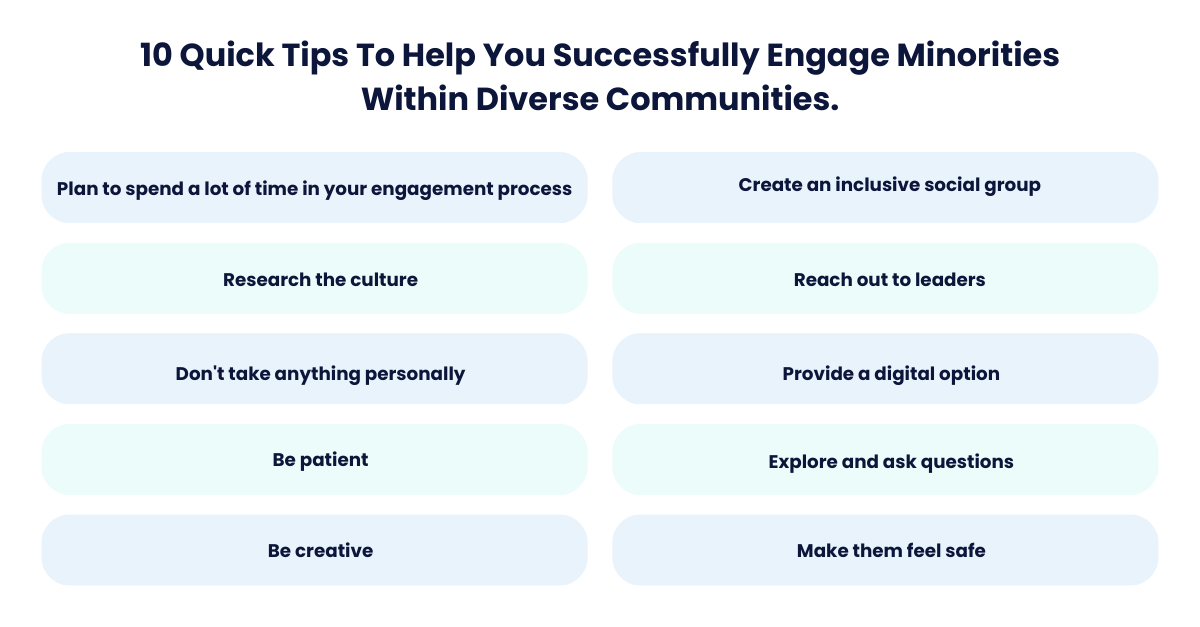Encouraging diverse communities to participate in community engagement can be an overwhelmingly tough task. It’s too often that these community members don’t participate in consultations for various reasons.
Consulting with minorities is substantially different than the process of a general community consultation and can be extremely complicated and sometimes even frustrating. Nurturing positive relationships with diverse communities is essential to ensure that minorities feel comfortable giving feedback in community consultations.

The best thing you can do is plan ahead. So, here are 10 quick tips to help you successfully engage minorities within diverse communities.
- Plan to spend a lot of time in your engagement process – prepare, consult, and report
- Research the culture
- Don’t take anything personally
- Be patient
- Be creative
- Create an inclusive social group
- Reach out to leaders
- Provide a digital option
- Explore and ask questions
- Make them feel safe
1. Plan to spend a lot of time in your engagement process – prepare, consult, and report
It’s important to engage with members of your community, from the very beginning of your consultation, and to remain communication even after your project, to help create long lasting relationships.
Whether you are introducing a community dialogue, a public forum, or a participatory decision-making endeavor, allocating time for planning, consulting, and reporting stages is crucial. This will help pave the way for meaningful interactions, inclusive discussions, and establish better connections with participants.
2. Research the culture
There is nothing worse than consulting a specific minority group and not having a general understanding of their cultural norms. For example, certain cultures discourage women from expressing their opinions while others are discouraged when disagreeing with authority. Therefore, conducting prior research into the cultural context, councils can proactively identify these potential barriers.
With this understanding, councils can then tailor their engagement, to create inclusive environments and communication alternatives that respect cultural sensitivities. This proactive effort not only ensures a a more productive consultation, but also demonstrates a genuine commitment to engaging with minority voices in a meaningful and respectful manner.
3. Don’t take anything personally
Cultural differences can often leave people feeling confused or out of place, so don’t think too much about a specific instance that made you feel uncomfortable or offended. Forget about it, move on and remember that your goal is to gather community feedback and create a relationship with the minority group.
4. Be patient
If you’ve ever been to another country, you will understand the importance of patience when it comes to language and cultural barriers. Think about how hard it would be to express your feelings about a certain topic to someone who doesn’t speak the same language as you and put yourself in their shoes.
5. Be creative
Think of ways that you can make it easier for these community members to participate. This will take some extra time, but imagine if you could sit down with someone who speaks a different language one-on-one and ask them to express their feelings about a specific topic to you using emojis, pictures or simply drawing like a game of Pictionary. Spending time with them will make community members believe that you really care about their feedback.
6. Create an inclusive social group
Sometimes creating an event at your community center or a weekly coffee event specifically for the minority you are trying to reach is enough to bring people together and encourage them to engage while assuring that you have a particular interest in them. Being involved in the event is a great way to build lasting relationships with these community members.
7. Reach out to leaders
In many minority groups within a community, there will be some members who are considered leaders. By reaching out to these people, you can often gather feedback which is representative of a large part of the group. Often times when other group members see their leaders engaging, they will feel more confident that they have the opportunity to engage as well.
8. Provide a digital option
While this has many benefits, it can also come with barriers. A digital option gives community members the option to engage anonymously from the comfort of their own home. But if the minority group speaks a different language, this can create issues.
There are ways around this barrier – you can provide the digital engagement option in their language or show them how to translate their entire web browser to be in their own language. Although a digital option for diverse communities can sometimes seem like a lot of work for you, the benefits that community members experience are worth it.
9. Explore and ask questions
Nothing makes a minority feel more important than when people are actually interested in their culture. Make sure that you are actively listening and spending time with these community members by asking questions and really getting to know them and their way of life.
10. Make them feel safe
Offering feedback to a local council can be daunting task, especially for individuals from minority groups. This could be a result from groups often being marginalized, power imbalances, language barriers, or past negative experiences could’ve made approaching authorities to be intimidating.
To ensure that not only people have a voice, but that their voice matters, local councils should prioritize inclusivity by actively involving minority voices, providing diverse communication channels, and demonstrating a genuine commitment to addressing concerns. Such efforts can help diminish the intimidation factor and foster a more open and trusting environment for all community members to participate.
Whether you’re engaging a specific minority within your community or using an inclusive engagement consultation for multiple minorities within your community, make sure you take the time to understand the various cultures.
This article was updated from 2018.












